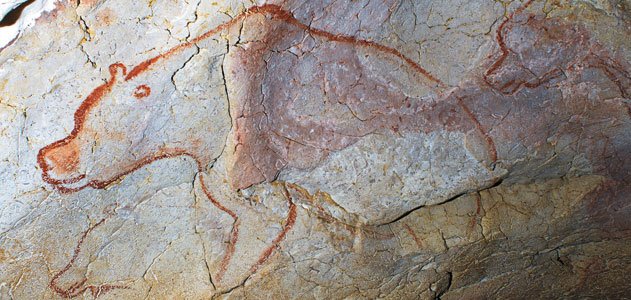Here’s another look at our specimen from last Friday.

Really very nicely preserved. This fossil was collected in Romania, and it’s the baculum of a cave bear. What is a cave bear? Species Ursus spelaeus, a bear that perhaps fortunately went extinct about twenty-four thousand years ago, during the last glacial maximum. These bears were huge: as big as modern polar bears! Although chemical evidence suggests they ate a largely herbivorous diet, there is also plenty of fossil evidence that they at least occasionally ate meat. Their diets included such delectables as their fellow cave bears, particularly those who died during hibernation, and probably the occasional human ancestor. To be fair, it’s likely we ate them, too.
Our human ancestors (and Neanderthals, which are perhaps our ancestors as well) were interested in these giant bears. The bears often feature in cave paintings, like the one below. We’ve also found sites that suggest ritual or religious behavior involving these animals. Frankly, if I was sharing my world (and my precious cave space) with these giant bears, I could see myself developing some ritualistic means to conquer or appease them, but that’s just how I roll.

And of course, this fossil raises another exciting question: What is a baculum? I’m sure there’s someone else out there with a vaguely adolescent mind giggling about this. A baculum is a penis bone. This physiological structure in common in placental mammals like ourselves, and even in the other large primates, such as gorillas, chimpanzees, and bonobos. Human males, however, do not possess this bone. Why did we lose it? Not sure. They do seem to be a vestigial structure in the great apes, and are particularly tiny in chimps and especially in bonobos. The baculum’s primary function seems to largely be enabling males to have sex for long periods of time. It’s possible the structure became too evolutionarily costly to maintain as our species’ sexual behavior changed to shorter, more frequent matings..
The winner this week? John Macdonell! Congratulations and thanks for playing! And commenters, don’t you get too crude on me, or I’ll never show you fossil penises again! If you have a fossil you want to share, send your pictures to me at schoerning at ncse.com.

